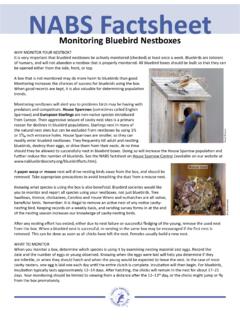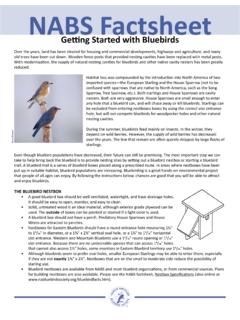Transcription of NABS Factsheet - North American Bluebird Society
1 NABS Nestbox Recommendations Materials Both -inch wood and PVC pipe are commonly used for Bluebird nestboxes; Peterson and Troyer nestboxes often use 2 x 4 inch boards Use exterior grade material such as exterior plywood Do not use pressure treated wood because it includes toxic compounds Do not use paper milk carton style or corrugated cardboard boxes Woods such as redwood, cedar, and cypress are long-lasting even when left naturalNestbox Plans Because of regional variation in predators, climate, and other factors, nestbox styles or nestbox features that work well in one area may not work well in others Many good nestbox plans are available.
2 Contact Bluebird monitors in your area to learn what works best where you are (the NABS website lists our Affiliate organizations, which will be able to help you with region-specific information: )Entry Holes Eastern Bluebirds use 1 to 19/16 inch round holes, 1 x 2 inch vertical oval holes, or 1 to 13/16 inch horizontal slot entrances Western and Mountain Bluebirds use 19/16 inch round openings or 13/16 inch slot entrance Where the ranges of the species overlap use the larger openings Oval holes should only be used in Eastern Bluebird boxes with moderate- to small-dimensioned nestboxes to reduce the possibility of European Starling use The recommended depth from the bottom of the entry hole to the floor is commonly 4 " to 6"Floor Sizes Eastern Bluebirds.
3 Floors in wooden nestboxes are commonly 4 x 4 or 5 x 5 inches (Peterson-style boxes are somewhat smaller), floors of circular nestboxes (such as PVC pipe) should be approximately 4 inches in diameter Western or Mountain Bluebird nestboxes should be at least 5 x 5 inches or 5 x 5 inches to accommodate larger clutch sizesAccess It is imperative that all Bluebird nestboxes open readily from the top, side, or front to facilitate box monitoring and cleaning Many Bluebird monitors prefer a door that pivots at the bottom If nestbox sides or front pivot at the top to allow access, they should do so at as high a point as possible to ensure that you can observe tall nests without the door obstructing your view A screw or angled nail in a pre-drilled hole should be used to ensure that mammalian predators can not readily open the nestbox If vandalism or tampering are of concern, hold the door in place with galvanized screws preferably Phillips head or deck screws, which require a square- or star-shaped bitColors Natural wood is acceptable If painted or stained.
4 Use light colors to reflect the sunlight to reduce overheating during very warm weatherWater-Resistance/Drainage Drainage holes may be provided in the box bottom to allow any rain entering the nestbox to drain and to provide air circulationNABS Factsheet The nestbox should be built to prevent water from entering The roof should provide sufficient overhang beyond box entrance or vent holes to minimize possibility of rain entering these openings; an overhang of 3" in the front and 2" on each side is recommended The roof should cover top edge of the nestbox back unless other features eliminate any possibility of rain entering the joint between back and roof even if the wood warps Heat/Cold Protection Vents providing ventilation may be included near the nestbox peak.
5 These openings should be protected from rain by having the roof overhang a sufficient amount to minimize precipitation entering the nestbox Vent holes may not be appropriate in areas with gnats Dark colors should be avoided to minimize overheating It should be possible to plug or cover vent holes during cold weather periods early in the nesting period Long roof overhangs minimize the possibility of sun, rain, or snow entering the nestbox Predator deterrence The nestbox should be easy to mount on a predator-resistant post in areas with climbing predators such as raccoons, cats, or snakes A 5-inch roof overhang above the entrance hole reduces the possibility of predation Wooden guards placed over the entry hole are not effective in eliminating raccoon predation (although a wooden guard or metal plate can prevent squirrels or woodpeckers from enlarging the entry hole)
6 Nestboxes mounted on waxed metal electrical conduits may deter climbing predators Mounting nestboxes less than 5 feet from the ground increases the opportunities for climbing or jumping predators to raid the nest Wooden posts, unwaxed pipes, and PVC pipes are readily climbed by nest predators such as snakes and raccoons For more information, see the NABS Factsheet Predator Control ( )Mounting Nestboxes should be designed so that they may readily and securely be mounted on a support post such as water pipe or electrical conduit Fence posts are risky because of climbing predators Having the back extend below the main nestbox body will allow you to attach the nestbox with screws, nails, pipe clamps, wires, or u-bolts Alternatively, a large hook can be installed on nestboxes, which can then be hung in trees by using a long pole.
7 The Southern California Bluebird Club has had good success with this method; they are an excellent source of information. For more information, see the NABS Factsheet Predator Control ( )Perches Perches should never be used on any Bluebird nestboxes because they are not needed by bluebirds and only facilitate harassment by non-native species such as House SparrowsInner Walls Interior walls are generally not painted or stained, but can be if non-toxic products are used. The front wall below the entrance hole should feature a rough surface to facilitate chicks climbing to the entry hole; if the surface is smooth, cut shallow grooves ( kerfs ) across the wall Hardware cloth is not recommended for a climbing surface as birds may get their feet caught in itParasite Control Nestboxes with raised screen floors may reduce blowfly infestations, although this has not been proven conclusivelyRevised June 2012 Bet ZimmermanKerfs







